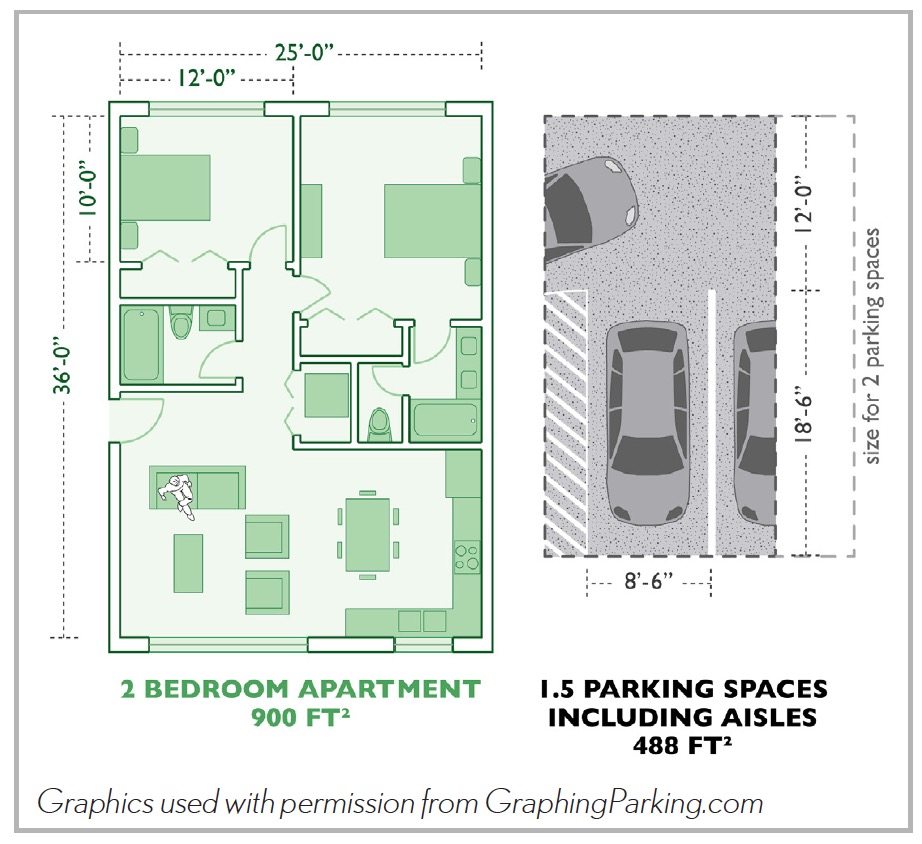CENTER FOR NEIGHBORHOOD TECHNOLOGY
Executive Summary
 Late at night, when Chicago sleeps, apartment parking lots are at their peak usage. When CNT visited those lots and garages at 4:00 a.m., though, we found one third of the parking spaces sitting empty.
Late at night, when Chicago sleeps, apartment parking lots are at their peak usage. When CNT visited those lots and garages at 4:00 a.m., though, we found one third of the parking spaces sitting empty.
This may not seem like a huge problem, but each indoor, underground parking space – one individual space – costs $37,300 to build. Multiply that by all of the spaces in the lot, and the price tag is huge. We think that wasted money and space should be allocated to housing instead.
As we began to dig into this issue, some important questions emerged. How does that unused parking impact communities? How much of it exists? And how can rethinking how much parking cities mandate promote neighborhoods that are more compact and affordable with access to frequent transit?
To find out, CNT interviewed multifamily developers in Chicago and found that when communities ask developers to build too much parking, those spaces add time and money to projects. They drive up construction costs and rents for market-rate units. And parking requirements hinder the development of affordable housing near transit because subsidy programs cannot account for the dual price premiums on parking and land.
We then applied CNT’s pioneering approach to determining parking demand. When we built parking calculators for King County, Washington; the San Francisco Bay Area; and Washington, D.C., we visited parking lots and garages at 4:00 a.m., when most renters have parked their cars and are asleep in bed. Across all three cities, we consistently found one third of those residential parking spots sitting empty. So we decided to take the same approach at 40 affordable and market-rate apartment buildings across Chicago.
Consistent with our research elsewhere, we discovered that:
- THE SUPPLY OF PARKING EXCEEDS DEMAND. Buildings offered two spots for every three units. In reality, they only needed one for every three.
- AS PARKING SUPPLY GOES UP, MUCH OF IT SITS EMPTY. Apartments with fewer spaces saw a greater percentage of their parking used.
- APARTMENT BUILDINGS NEAR FREQUENT TRANSIT NEED LESS PARKING. Buildings within ten minutes of a Chicago Transit Authority (CTA) train stop had one spot for every two units. Even then, one third of their spots sat empty.
- THE OPPORTUNITY COSTS ADD UP. If we applied these numbers to a 100-unit building near the CTA system, the empty parking spaces would add up to $825,000 in wasted construction costs.
Municipalities often mandate at least one parking space per new housing unit, even for buildings near transit stops. But with so many costly parking spaces already sitting empty, communities should rethink parking as a resource to be managed so that supply and demand can be more in sync. If that happens, parking costs decrease and the supply of market-rate units can expand. Affordable housing developers can stretch subsidies further. And land could be used more efficiently for retail, services, and amenities, making it easier to get to them without driving. This would reduce parking demand even more.
This report shows how it can be done:
1. Municipalities must right size their parking requirements to reflect the real demand for off-street parking near transit and create incentives to pass on the savings through affordable rents.
2. Developments only need a handful of spots when they include access to amenities like transit, car sharing, and bicycle sharing.
3. Good data can support more productive conversations when low-parked buildings are proposed at neighborhood meetings.
Chicago and its northern neighbor Evanston recently reduced parking requirements around transit for developers that include affordable housing. Regionally, however, high minimum parking requirements are still the norm. The data and recommendations in this report lay the framework for transit-oriented development that puts people before cars and passes on the value savings through more affordable rents.
Together, we can build communities with room for parking, amenities, and housing available to everybody. This report shows the way.
Download full version (PDF): How Empty Parking Spaces Diminish Neighborhood Affordability
About the Center for Neighborhood Technology
www.cnt.org
“Founded in 1978, the Center for Neighborhood Technology is a national leader in promoting more livable and sustainable urban communities. We research, invent, and test urban strategies that use resources more efficiently and more equitably. We believe that cities, thanks to their dense population and shared resources, are uniquely positioned to respond to the growing concerns about sustainability, resource efficiency and greenhouse gas emissions. By building on what exists – infrastructure, natural resources, organizations, and institutions – our initiatives uncover important hidden assets, enhancing urban communities and the lives of their residents.”
Tags: Center for Neighborhood Technology, Chicago, CNT, Housing, IL, Illinois, Parking






 RSS Feed
RSS Feed